A plethora of new digital tools provide powerful ways to put information about your products into the hands of today’s tech-savvy consumers.
BY GARY JAMES

From sophisticated diagnostic systems that assess sleep needs to virtual reality, mobile videos and new online resources, digital tools are providing a powerful new way for manufacturers to deliver information about their products—and for retail sales associates to more effectively serve consumers. While adoption is still at an early stage, as more and more Millennials enter the marketplace, technology will no longer be a novelty but an expectation in every area of retail—from product to marketing, many industry leaders predict.
“Younger consumers are growing up immersed in technology,” says Martin Rawls-Meehan, president of adjustable bed and mattress maker Reverie in Bloomfield Hills, Michigan. “They are used to seeing technology in everything they have and everything they do. As an industry, we need to work harder to put technology to use in our products and in the way we communicate with our customers.”
Along these lines, Reverie is in the process of testing a new mattress selector tool with key retailers that will help consumers “find the right sleep system for their needs in an easy and simple way,” Rawls-Meehan says.
The match game

The Simmons’ SIMulator virtual reality app enables shoppers to explore layers of mattress construction to learn about specific product benefits.
Kingsdown, which pioneered the use of diagnostics to help consumers select mattresses, continues to refine and enhance its patented bedMATCH system. Based on scientific research by the company’s Sleep To Live Institute, bedMATCH uses 18 statistical measurements and more than 1,000 calculations through an in-store module to build a profile of shoppers based on their unique sleep preferences.
The process takes about five minutes, after which the system provides a personalized printout with color-coded recommendations about which mattresses on a showroom floor would provide the best postural support. Using those recommendations, shoppers then lie down on the chosen models and select the one that provides the optimal level of comfort and pressure relief.
The Mebane, North Carolina-based company also offers an initial diagnostic screening that consumers can do online before entering a store.
At the winter Las Vegas Market in January, Kingsdown introduced a new mobile app that enables RSAs to retrieve information from anywhere in the store. The app includes a new proprietary “Interface Pressure Relief” feature that “for the first time, quantifies and measures comfort,” says Frank Hood, president and chief executive officer of Kingsdown. “The tool enables shoppers to assess, on a gradient, how a sleep surface feels in a more scientific way, similar to the way you would assign a measurement of degrees to temperature.”
Shopping for a mattress today is “a challenging proposition,” Hood says. “Consumers have so many choices and they often are uncertain about whether they are making the right decision. For most, the last time they bought a mattress was probably 10 years ago, so they have a lot of anxiety about the process.”
Another factor contributing to shopping stress is the fact that, in some stores, they may be working with a newly hired RSA. That RSA may still be learning the features and benefits of specific products and not be as skilled at identifying consumers’ needs as a more veteran salesperson.
“With bedMATCH, RSAs have a proven tool for assessing consumers’ comfort and support needs,” Hood says. “It provides an easy way for RSAs to get the information they need from the customer and quickly identify a select group of beds that would be most appropriate to test.”
While retailers can decide how many beds the system will recommend, Hood suggests a maximum of six or seven in a range of price points and constructions. “Anything more risks confusing the customer,” he says. The system is designed so that every bed on the floor is part of the equation.
“Our system can include all the models on a retailer’s floor, so no one brand is favored over another,” he says. “The goal is to help the consumer find the right bed for their needs, regardless of brand.”
Kingsdown’s research shows the use of bedMATCH results in higher sales tickets, with consumers putting more value on the features and benefits of the bed rather than dwelling on price alone. Sixty percent of consumers using bedMATCH purchase a bed set between $2,200 to $2,400, he says—an increase of $315 in the average unit selling price.
Hood adds that the database Kingsdown has developed through the use of bedMATCH at retail is a rich source of marketing insights. The data contains more than 9 million buyer profiles, offering retailers myriad opportunities to gain insights into their markets and consumers.
“Our data shows which types of people prefer which types of beds, based on age, gender, height, weight and a host of other factors,” Hood says. “We even can tell how many people in different age groups have medical conditions such as lower back pain or acid reflux. We use this information in our product development—and retailers can use it to shape their marketing messages.”
Going forward, the use of Big Data will grow more and more important to retailers, Hood says. Such information will enable them to more precisely track shopper behavior, customer demographics and other patterns, and lead to the creation of more effective marketing campaigns and merchandise mixes.
Hood says bedMATCH also gives retailers a powerful “dashboard” that they can use to track sales productivity and other performance metrics for individual RSAs, such as closing rates, sales tickets and rates of return.
Creating confident shoppers
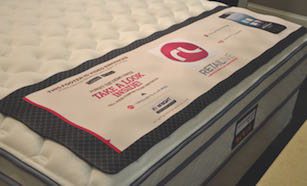
Using Wright Global Graphics’ RetaiLive app, retail sales associates can quickly access product videos for models of interest.
To demonstrate the impact its Reveal pressure-mapping technology can have on sales floors, Calgary, Alberta-based XSENSOR Technology Corp. created the feeling of a retail environment in its new permanent showroom at the winter Las Vegas Market. Available in both kiosk and wireless versions to fit a variety of spaces, Reveal uses a highly accurate pressure-imaging system to display a dynamic, high-resolution body pressure image that assists in making mattress recommendations.
The company also offers custom branding options to retailers and manufacturers so they can promote the unique characteristics of their systems and differentiate themselves in the marketplace.
“Reveal is changing the mattress-buying experience,” says Richard Brass, XSENSOR’s vice president of business development for North American sleep products. “It provides customers with real-time insights and unbiased recommendations that help them be confident that they have found the right mattress.”
With 1,664 built-in sensors, Reveal yields an on-screen, pressure-point analysis that helps shoppers visualize their correct comfort levels. Based on that assessment, which takes less than five minutes, RSAs then steer the customers to specific beds in a range of price points that have been identified as being right for their body types.
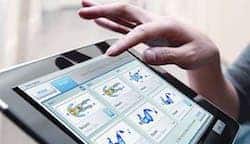
XSENSOR’s Reveal system allows shoppers to view results of their ComfortMap assessment while resting on the bed. The system recommends several models for testing based on specific comfort and support needs.

“The YouSleep program uses highly sophisticated pressure-imaging, allowing BrandSource members to help each individual customer find the right mattress solution. You would never leave a shoe store with a shoe that doesn’t fit, and buying a mattress shouldn’t be any different.”
The Tustin, California-based buying group BrandSource unveiled YouSleep to its retail members in August 2014 at its annual convention in Las Vegas. The program is still in the early stages, but retail placements of the system are steadily growing, according to Brass.
“YouSleep makes it easy for members to help their customers—and the positive shopping experience also builds loyalty,” Allen says. “When BrandSource stores use technology as part of their sales process, their average ticket increases, their close rate goes up and returns decline.”
Empowering consumers
Recognizing that a growing number of consumers like to start the shopping process from the convenience of home, Boyd Specialty Sleep is in the process of developing an online version of its Sleep Metrics diagnostic system for use on dealer websites. Based on research commissioned by the company, Sleep Metrics is an in-store kiosk with a diagnostic air mattress that helps RSAs determine the best level of support for specific body types and sleep styles.
“With our new online version, consumers will be
able to do virtual pressure mapping from the privacy of their homes,” says Denny Boyd, president of the St. Louis-based company. “They’ll get an initial recommendation based on their height and weight, which the RSA will confirm with another reading when they come into the store.’
Boyd says having at-home access to the system will “empower consumers, since it enables them to gather more insights at their own convenience.” It also will motivate them to visit stores, since their online diagnostic session will be accompanied by a coupon they can use for a discount on purchases.
Developed in 2008, Sleep Metrics has earned two patents. Over the years, the company has continually refined the system to enhance functionality. Recent updates include a new software package that delves more deeply into a consumer’s sleep habits, and the launch of an Android-based touchscreen app that can be carried through the store or attached to a pedestal.
“The Sleep Metrics system is a ‘win-win’—it creates a more consultative and professional experience for the shopper and boosts the selling skills and success of the RSA,” Boyd says. “By helping RSAs to more accurately identify consumers’ specific sleep concerns, it also enables RSAs to quickly find the best mattress, pillow and accessories to meet those concerns, increasing customer satisfaction and reducing or eliminating comfort returns.”
With RSA turnover an issue for many retailers, the Sleep Metrics system also provides an effective tool for initiating sales conversations, Boyd adds. “Every salesperson needs to ask probing questions to better understand the needs of the consumer. But very few salespeople, especially new hires, are able to do this quickly and effectively. With Sleep Metrics, they have a proven system for obtaining this information in just a few minutes.”
Shopping for a sleep system can be “an overwhelming experience,” Boyd says, as consumers are greeted by as many as 50 to 80 mattresses when they come into a store. With Sleep Metrics, three-quarters of the models on display are immediately eliminated, and consumers are steered to a focused selection of mattresses designed to meet their individual comfort and support profile. Beds are tagged with one of four comfort index numbers, allowing consumers to easily identify models that would be a good fit for their needs.
“Studies show that buying a mattress ranks right up there with buying a used car in terms of consumer discomfort with the process,” Boyd says. “Our technology takes something that is perceived as a challenge and a chore and turns it into a positive experience. Armed with the diagnostic data, they have the information they need to make an informed, confident decision.”
Instant access to information
Wright Global Graphics put a bright spotlight on new technologies for capturing consumer attention in the Design Lab it created for its showroom at the winter Las Vegas Market. Among the products featured were RetaiLive, a multiplatform system for accessing content on mobile devices, and new display techniques incorporating technology, such as electronic headboards.
“Mobile marketing and high-impact, visual advertising are the most effective ways to bring attention to product on a retail floor,” says Don Wright, senior vice president of business development and chairman of the Thomasville, North Carolina-based company.
Introduced in 2012, RetaiLive will roll out to a growing number of retail floors in 2015. In addition to Simmons, which debuted RetaiLive technology to its retailers last year, Restonic also has adopted the system. Restonic unveiled RetaiLive at the winter Las Vegas Market along with new enhancements to Brand Central—its retail “toolbox”—and a new digital publishing program that gives retailers access to a smorgasbord of content to use in their consumer-focused digital communications.
In its showroom during market, Wright Global introduced RetaiLive 2.0, an upgraded version of its original system that features more robust graphics, including 3D imaging and higher image resolution.
RetaiLive currently offers three tools for retailers: QR code technology (in which shoppers scan a barcode with their phone to access product information), image recognition technology (information is accessed by hovering a phone over key images on a product) and NFC, or Near Field Communication, a wireless technology. Seen as the wave of the future, NFC and other “beacon” technologies use a system of small, wireless transmitters that emit low-energy signals to send messages or prompts directly to smartphones or tablets within an immediate store environment. The system Wright developed, designed for use by RSAs, sends out targeted and contextual information specific to an individual small area where the mobile user is standing. Accessed via iPhone, iPad or Android smartphones, the system can be used to instantly trigger product videos and other product information when a shopper approaches a product.
“RetaiLive puts everything RSAs need to educate the consumer right at their fingertips,” Wright says. “It provides a way for the salesperson to quickly access complete, accurate information about specific models of interest to the consumer.”
Retailers of all types are adopting in-store wireless technology to provide customers with product information, flash sales or deals and to speed up the checkout process. To use such systems, an app is downloaded by either a consumer or a salesperson.
“We opted to empower RSAs with the RetaiLive app rather than consumers because most consumers don’t want to have to download an app and opt-in to join the network when they come into a store,” Wright says. “With our approach, the RSA is set up to access the information any time it is needed so that it can shared directly with the consumer. It gives the RSA another tool in their belt that enhances their credibility.”
Wright expects NFC technology use to accelerate but says the current lack of a single, globally accepted system standard poses a roadblock. “Apple insists on still doing its own thing with its iBeacon system, but hopefully we’ll have a universal standard in the future.”
New tools for RSAs
Seeking to help RSAs simplify and streamline the selling process, Atlanta-based Simmons has created a three-part, in-store tech package as part of its SIMposium retail sales initiative. The new digital tools include an online information hub called SleepSells.com; a virtual reality app called SIMulator that enables users to “see” inside Simmons mattresses; and Wright’s RetaiLive program, which provides instant access to Simmons-related content via mobile devices.
“The in-store selling process remains—industry-wide—fairly low-tech,” says Jeff Willard, executive vice president of marketing for Simmons. “We’ve developed this technology package to help thread that dynamic storytelling through the in-store experience.”
Previewed at the winter Las Vegas Market, SleepSells.com is a one-stop information hub for the retail sales community. The site houses a multimedia mix of information that RSAs can leverage to strengthen their sales pitches. Content includes behind-the-scenes looks at Simmons’ emerging products and technologies, insights on industry and consumer trends relating to sleep and wellness, and updates on retail best practices. Sharing and comment features will allow for two-way conversation among RSAs, Simmons’ Retail Account Specialists and company decision-makers. The site went live in February.
“SleepSells.com is the first manufacturer-developed site of its kind targeted exclusively to the RSA,” Willard says. “It provides a direct link between Simmons and our RSAs, facilitating a unique, personal dialogue that encourages learning on both sides.”
SleepSells received an enthusiastic response from retailers during its Las Vegas debut, according to Jim Gallman, senior vice president of brand management for Simmons. “They love the idea of a one-stop information hub for their RSAs, but more so love the idea of a manufacturer partnering with the retail sales community to develop holistic training and educational content that help RSAs become more successful, confident salespeople.”
During the winter Las Vegas Market, Simmons also announced that a new virtual reality version of the SIMulator app would be available for in-store use on iPad, iPhone and Android mobile devices as of February. Introduced as a beta test in July 2014, the SIMulator app enables consumers to learn about the key components of various Simmons’ models and the benefits they provide by “peeling away” the layers of the product. Interactive animation brings the company’s signature technologies to life, and more information about specific features is quickly accessed by pressing an “info” button.
Available on the App Store and Google Play, the SIMulator app was developed by Marxent Labs in St. Petersburg, Florida. The app is compatible with products from all of Simmons flagship lines, including Beautyrest Recharge, Beautyrest Recharge World Class, Beautyrest Recharge Hybrid, Beautyrest Recharge Memory Foam Plus and Beautyrest Black.
“This peek ‘behind the curtain’ is designed to increase consumers’ comfort and confidence, enabling RSAs to more easily close the sale,” Willard says.
In developing this new technology, Simmons worked closely with retailers and RSAs, Gallman says. “We’re actively engaging retailers to ensure we’re bringing the best tools to the table.” The app is designed for ease of use so that RSAs can keep up with today’s “fast-moving consumers,” he adds.
As part of this mission to provide new sales tools, Simmons also was the first bedding major to offer RetaiLive to its retailers. By scanning a designated area on the point-of-sale material, the RSA gains immediate access to an unlimited amount of virtual content created by Simmons for review and discussion with consumers.
RetaiLive currently is available on Beautyrest Black and soon will be available on the full Beautyrest Recharge line of products.
Rounding out its technology package, Simmons also introduced a series of short training videos in July 2014 called SIMple Facts. These 60-second videos are designed to explain one “big” idea, providing RSAs with quick, easily digested factoids to educate themselves and interested consumers. The videos are available on the Simmons YouTube channel and SleepSells.com. New content will be introduced throughout the year.
“These tools arm RSAs with information that takes away some of the mystery of the mattress purchase, which we know is one of the biggest roadblocks in the purchasing cycle,” Willard says. “By helping RSAs close the sale, we’re helping our business and theirs.”
Technology making beds smarter by the minute

Designed to adjust to kids’ sleep needs as they grow, the SleepIQ Kids bed from Sleep Number includes a head tilt feature for bedtime reading.
Marketing isn’t the only area in the sleep arena where technology is playing a bigger role. Increasingly, technology also is re-shaping the beds themselves, as producers incorporate creative applications of sound, lighting, sleep monitoring and other functions into new models. Here’s a quick roundup of recent developments:
■ SleepIQ Kids: At this January’s International Consumer Electronics Show in Las Vegas, airbed manufacturer and retailer Sleep Number unveiled the juvenile version of its SleepIQ technology. Billed by the company as “a smart bed for smart kids,” SleepIQ Kids offers a host of tools designed to
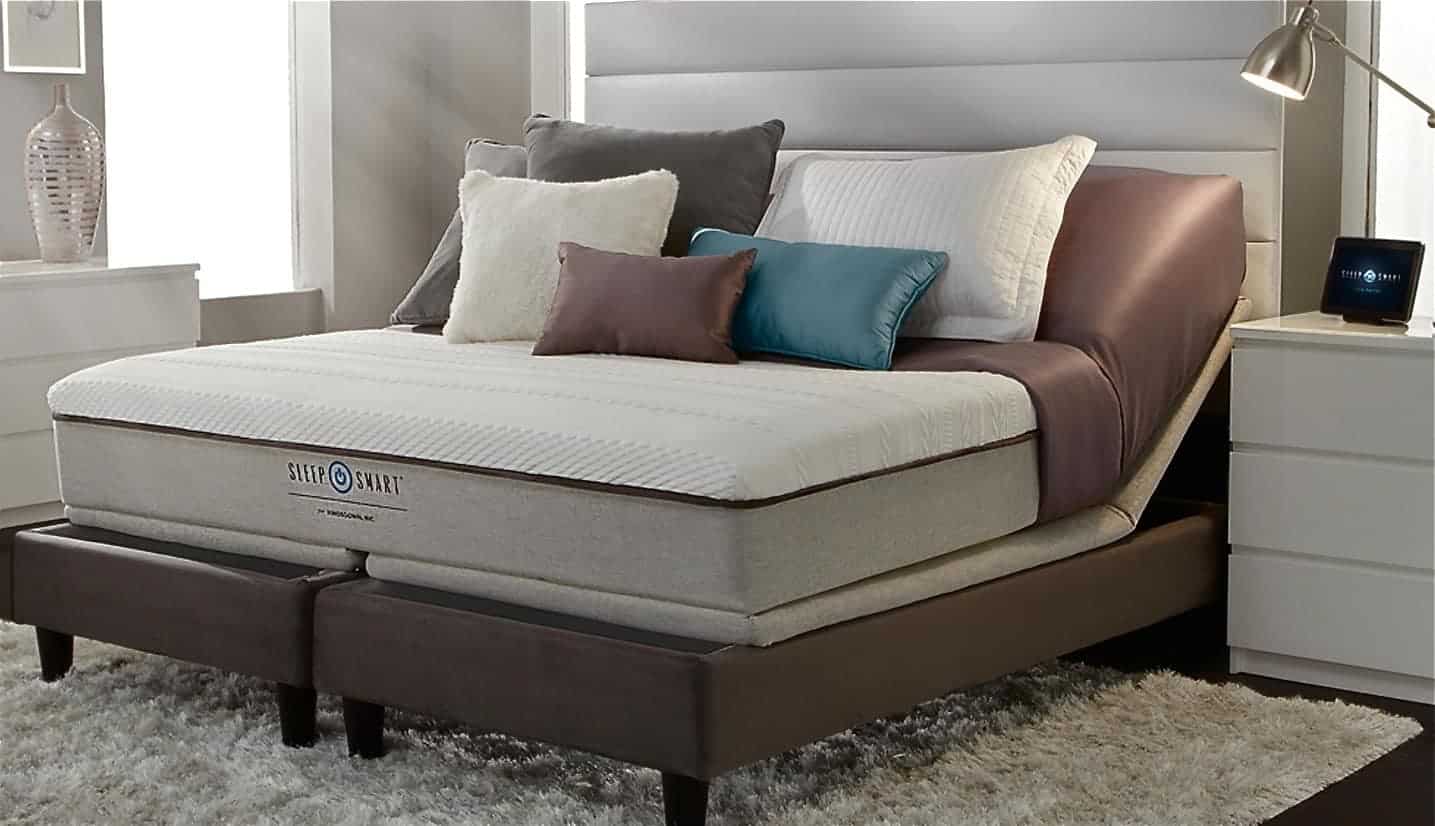
Mebane, N.C.-based Kingsdown’s Sleep Smart system uses technology to “read” a sleeper’s body, tracking sleep patterns and movement to create an individualized sleep surface.
enable children “to achieve their best possible sleep.” These include a SleepIQ dashboard for smartphones that allows parents to monitor the entire family’s quality of sleep, tracking heart rates, breathing and movement. SleepIQ Kids also alerts parents when a child gets out of bed or is having a restless night, and an under-bed module serves as a night light. The SleepIQ Kids bed was named an “honoree” in the 2015 CES Innovations Awards for its design, innovation and consumer value, in the home-appliance category. Targeted to toddlers through preteens, SleepIQ Kids is a follow-up to the Sleep Number x12 model with SleepIQ technology bed introduced at the 2014 CES. Sleep Number is based in Minneapolis.
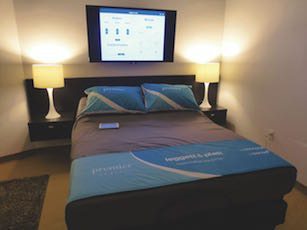
Up to five electrical devices can be integrated into the tablet control for Leggett & Platt’s Premier adjustable bed, allowing users to create programmable “room scenes” for reading, watching TV or sleeping.
■ Sleep Smart: Mebane, North Carolina-based Kingsdown continues to refine its technology-rich Sleep Smart bed, originally introduced in 2013. Using Kingsdown’s Scientific Measurement and Response Technology (SMART) sensors, the system monitors movement, assesses pain, eases pressure and tracks sleep patterns for later review. The sensors also automatically trigger air cylinders throughout the night that slowly expand or contract as sleepers change positions to adjust comfort. At the winter Las Vegas Market, the company introduced a new wand control for adjusting posture support. Other recent enhancements include upgrades to the bed’s software, which enables sleepers to more precisely control and monitor the bed for optimal “sleep efficiency.”
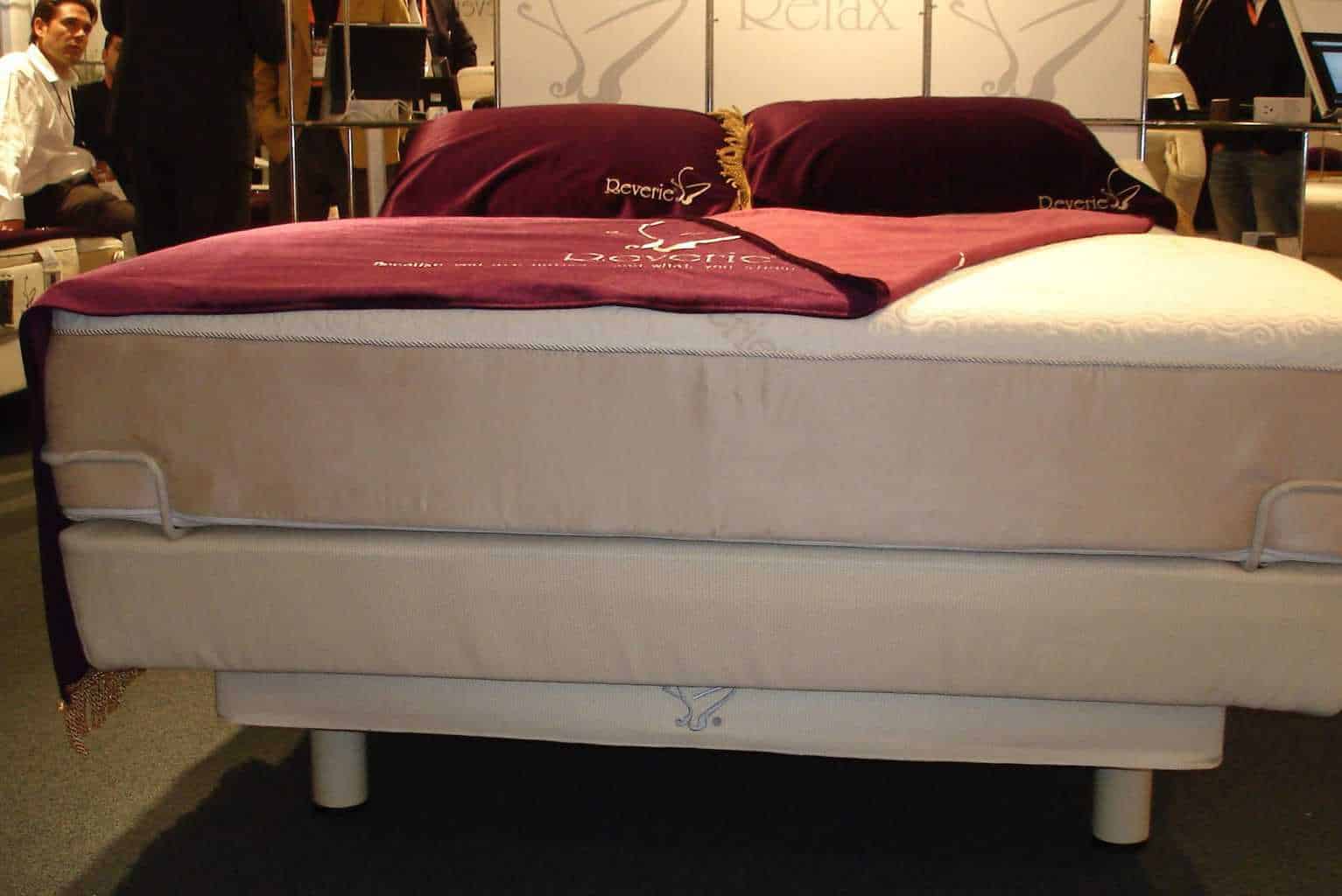
Reverie’s 8 series features Bluetooth Smart connectivity, ultra-quiet massage, a nightlight feature and unlimited adjustability.
■ The Premier Series: Introduced at the January 2014 Las Vegas Market, Leggett & Platt’s Premier Series is an adjustable base with LP Sense safety sensing that prevents people or pets from possibly being pinched when the bed is being returned to the flat position. The series also offers integrated under-bed lighting; dual, full-body massage with wave and pulse; and sleep and nap timer functions. The base features a convenient USB port on each side, a touchscreen tablet control and apps for Android and Apple devices. Leggett & Platt is based in Carthage, Missouri.
■ Reverie 8 Series: Another adjustable with all the bells and whistles is Reverie’s 8 Series. The adjustable foundation’s features include wireless remote control with two programmable memory positions; a Bluetooth Smart mobile module that allows control of the bed via Apple smartphone or tablet; under-the-bed nightlight; ultra-quiet massage feature; and individualized massage control. The 8 Series base also incorporates a proprietary four-speaker surround sound system with Bluetooth technology, enabling consumers to stream music wirelessly from their smart devices. Reverie introduced the Series 8 at the winter Las Vegas Market.
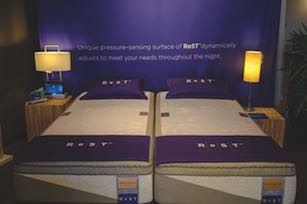
The new ReST Bed, due to launch at retail in April, uses a layer of “smart” fabric to detect and respond to body pressure, position and movement.
■ ReST Bed: Introduced at the January CES, Responsive Surface Technology LLC’s new ReST Bed uses a patented “smart” fabric spread beneath the outer layer of the mattress as the trigger for a dynamic sleep environment that continuously adapts to the needs of the sleeper. The smart fabric starts the process by sensing the sleeper’s body pressure, position and movement. It then reports that data to a microprocessor in a silent pump, which automatically responds by adjusting air in and out of 18 air chambers to deliver optimal comfort and support. Similar technology is used by Memorial Sloan-Kettering and the Atlanta Spine Center to help patients with spinal injuries. The first ReST Beds are set to hit retail starting in April. ReST is based in Atlanta.
New software tools spur innovation in ticking design

DesleeClama’s Cloud-based configurator allows ticking designers and product development teams to collaborate on new mattress designs via their computers and tablets.
Recognizing the potential that technology holds to streamline product development, enhance collaboration and cut costs, a number of leading ticking and trim producers are developing new software tools to aid their design process.
Ticking major DesleeClama, based in Zonnebeke, Belgium, has introduced new Cloud-based design software that it says revolutionizes the mattress design and development process. The technology, which will be shown at the Interzum fair May 5-8 in Cologne, Germany, is an evolution of an iPad-based tool the company introduced in 2013 and demonstrated to mattress manufacturers at the 2014 ISPA EXPO in New Orleans.
The new design configurator allows designers, salespeople and customers to collaborate and create complete mattress concepts from scratch on their computers and tablets.
“Starting from your preferred shape and size, you build up an entire mattress design,” says Craig Dunlop, president of Deslee Textiles USA in Inman, South Carolina. “You choose and change the height, the rounding of the corners and the edges with just a few taps. Once the basics are ready, one can start to dress up the mattress with fabrics, borders, zippers and embroideries—in the shape, color and texture you want. If you’re not satisfied, you can modify or customize the design at any time.”
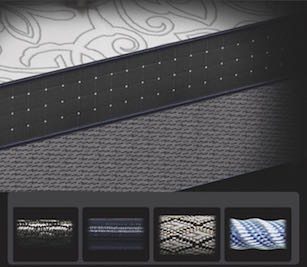
CT Nassau introduced a proprietary design app at the 2014 ISPA EXPO that enables mattress manufacturers to view various ticking, border, base and trim options on bed models in development.
Once a design is completed, the system enables salespeople to configure a chosen product within the available production constraints and to send out their design proposals and quotes to customers as a simple image or as an online, interactive 3D presentation. Every stage can be linked to an ERP or CRM system and even to production, ensuring that every design is verified and that production is feasible.
“The software offers real-time monitoring of user, usage, designs and trends,” Dunlop says. “And this configurator is fully scalable: It can handle an unlimited amount of content, clients or consumers.”
Mattress tape and ticking supplier CT Nassau, based in Alamance, North Carolina, introduced a proprietary design app at the 2014 ISPA EXPO that was “a huge hit,” says Rose Fleming, design manager. “Since then, we’ve continued to refine and perfect the technology.”
Developed by Valentino Stellini, managing director of sister company Stellini Textile Group in Milan, CT Nassau’s new iPad app enables mattress manufacturers to view various ticking, border, base and trim options on bed models in development and “get a good sense of what products will look like before they are built,” Fleming says. “The app gives them more confidence about the products they are developing, since they can easily share the designs by email and get opinions from their customers. That saves time, money and trouble.”
The app also makes it much easier—and affordable—for producers to experiment with color and pattern combinations, Fleming adds, “since you don’t have do an actual prototype until you get to the point where you’ve decided what looks best.”
Fabric solutions provider Creative Ticking, based in Gastonia, North Carolina, also added a new software tool in 2014 that enables designers to easily share color and pattern ideas with customers via computers, tablets and smartphones. The tool recently was expanded with a mapping function that simulates the look of fabrics on mattresses for easy customer viewing.
“This technology enables our customers to quickly access our designs, which enhances their creative ability,” says Constance Sousa, director of design and merchandising. “It empowers us to target a more focused styling process, which in turn saves time and development reworks.”
Another company using technology to expedite the design process is ticking and upholstery fabric supplier Culp. The High Point, North Carolina-based company uses a digital Design Mapping application as it works with manufacturing partners to create new products.
“We no longer have to spend a lot of money mocking up prototypes,” says Tara Bulla, Culp’s creative director. “With this mapping program, we can take the genesis of an idea and explore how different panels, borders and trim will look on a virtual representation of a finished product. It opens up a wider range of design possibilities—and makes the development process much faster.”
Strides in packaging protect the product
With the volume of sleep products being sold online rising steadily, the ability to ship mattresses quickly and damage-free is becoming increasingly important. The bulky nature of mattresses makes them difficult to ship efficiently, and protecting the cell structure of foam while still making the product compact poses another challenge.
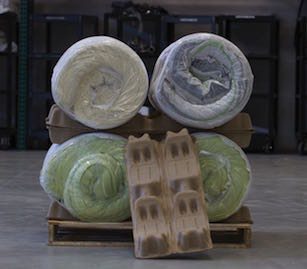
A group of foam mattresses await shipment after being rolled and wrapped by C3 Corp.’s new CWU2000 machine.
To serve the emerging e-commerce market, C3 Corp. developed new technology designed to roll-pack any foam mattress, topper or other foam sleep product for efficient shipping without folding. Its new CWU2000 machine combines a roll-pack system and bagger in one system. According to C3 Corp., the machine increases traditional freight shipping capacity and storage space by more than 60%.
The machine packages king, queen and twin-size foam mattresses all to the same size: 38.5 inches by 19 inches. It also can flat-pack and auto-bag mattresses. The system can bag 2.5 mattresses per minute or roll one bed per minute.
“The CWU2000 addresses manufacturing and marketing needs by providing a better package, increasing freight capabilities and reducing packaging waste,” says Joe Van De Hey, president and chief executive officer of the Appleton, Wisconsin-based company.
Recovery times for mattresses compressed and packaged by machine vary by humidity and temperature in a room, as well as the type of foam used. For mattresses compressed using the CWU2000, once the product is unwrapped and exposed to air, the foam slowly comes to life and returns to its original form. Because the mattress is never folded, instances of product deformation are minimized and recoveries are quicker, according to C3.
In addition, the unique lateral compression capability of C3’s technology “should allow greater uniformity of compression forces,” also reducing the chance of product deformation, says Bruce Peterson, CEO of Peterson Chemical Technology in Fort Smith, Arkansas.
A recent survey by Sealed Air underscores the stakes involved in shipping products damage-free. In that survey, 58 percent of Americans said that if they receive a damaged or broken product from an online order they would either consider purchasing from a competitor or not purchase from that retailer again.
C3 Corp. has a patent pending on the new mattress-compression system. The CWU2000 also is being distributed by Atlanta Attachment Co., which showed the new system at the 2014 ISPA EXPO in New Orleans.
Other suppliers that offer foam compression and packaging equipment include Leggett & Platt’s GSG division in Carthage, Missouri, and American Plant & Equipment in Roebuck, South Carolina.
BSC digital tool should benefit consumers, retailers alike
The Better Sleep Council, the consumer-education arm of the International Sleep Products Association, is developing a digital tool to help educate shoppers, facilitate discussions with retail sales associates and make consumers more confident about their purchase decisions. Targeted for launch later this year, the new tool is being designed with the input of BSC committee members, ISPA members and key retailers. BSC’s strategic consultant, Cleveland-based Marcus Thomas, is contributing to the project.
“The BSC is devoted to educating the public about the importance of sleep to good health and quality of life, and the value of the mattress in pursuit of a good night’s sleep,” says Mary Helen Uusimaki, vice president of marketing and communications for ISPA. “However, the mattress-shopping experience can confuse and intimidate consumers, even those who understand that a high-quality mattress can deliver better sleep.”
BSC research shows that many consumers are averse to mattress shopping because they do not know what they need, where to start or what questions to ask when they speak with an RSA. Since most shoppers have not purchased a new mattress for more than a decade, they often have a limited understanding of current offerings and are bewildered by the array of choices and variety of price points.
“The BSC has an opportunity to leverage its unbiased expertise to build consumers’ confidence in their purchase decision process,” Uusimaki says. “Prospective customers will be more confident in buying a new and better quality mattress if they increase their knowledge about their personal needs and preferences, as well as the importance of their sleep environment to satisfying them.”
The digital tool will guide shoppers in how to assess their sleep-system requirements. The tool also will provide guidelines on how to evaluate a mattress, using the BSC’s proven SLEEP test or EASE method, and offer an electronic means for shoppers to document levels of comfort and support as they test mattresses in a store environment. Information sharing via social media also will be available.
Designed to be accessible to consumers throughout the entire mattress-shopping process, the new technology will be compatible for use on iPhone and Android phones, as well as desktops and tablets.
“Our goal is to make the tool a ‘win-win’ for both customers and retailers,” Uusimaki says. “By closing the ‘anxiety gap’ for prospective mattress buyers, we expect to create more selling opportunities for mattress retailers.”
Uusimaki adds that the tool also is expected to help support increased sales tickets since “shoppers spend more when they have a better understanding of why they are buying a new mattress and feel more confident about making the investment.”
Keeping track
Whether it’s through wearable fitness trackers such as Jawbone Up and Fit Bit Flex, bedside devices such as Beddit’s Sleep Monitor and ResMed’s S+ or smartphone apps such as Sleep Cycle and SleepBot, a growing number of Americans are gathering new insights into their sleep patterns and building a heightened awareness of the role of sleep in their daily activities through a range of affordable new technologies.
According to IHS Technology, a market research firm based in Englewood, Colorado, global revenue for sports, fitness and activity monitors will rise by 46% from 2013 through 2019, expanding by nearly $1 billion to a total of $2.8 billion as health-conscious consumers rush to buy devices ranging from heart-rate monitors to running computers. The total number of activity trackers in use will expand to 120 million units in 2019, up from 84 million units in 2013.
Most activity trackers available to consumers use small motion detectors called accelerometers to detect movement. “The simple theory is movement equals wakefulness and prolonged lack of movement equals sleep,” says Dr. W. Christopher Winter, a Charlottesville, Virginia, neurologist in a blog post about sleep monitors on HuffingtonPost.com. “This technology, known as actigraphy, has been around for decades and is a useful tool for mapping general patterns of sleep.”
Some companies claim they can provide detailed sleep quality measures with actigraphy, he adds, but “to do so would be the equivalent of determining how well a car is driving by its odometer reading alone.”
While the effectiveness of these devices varies, each has its place in fitness and sleep monitoring, Winter concludes.





